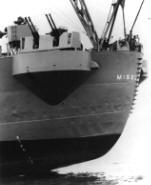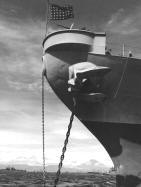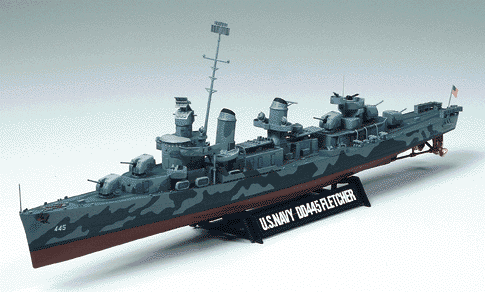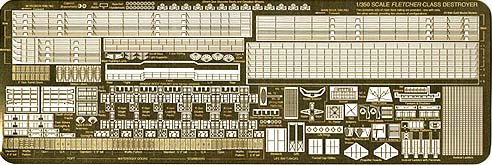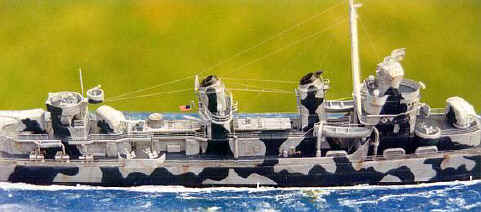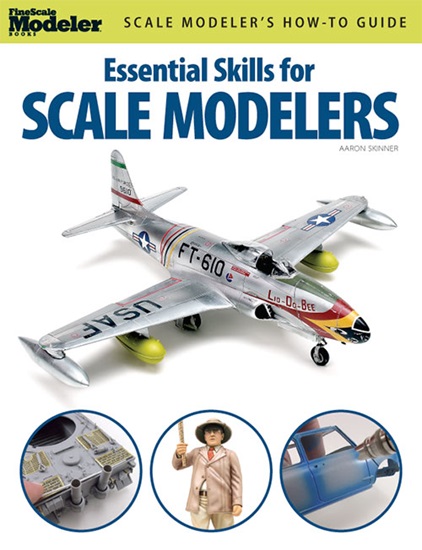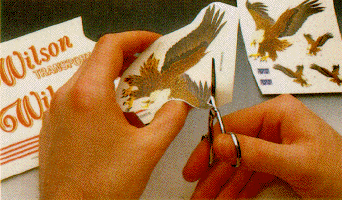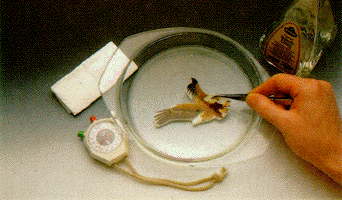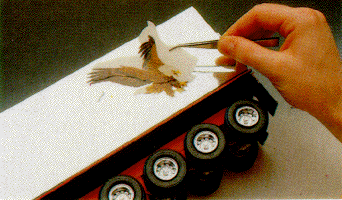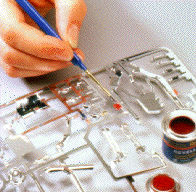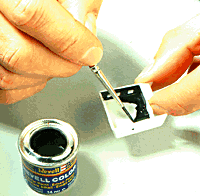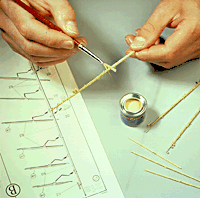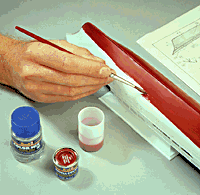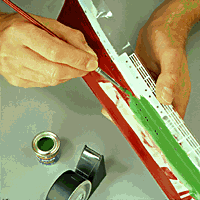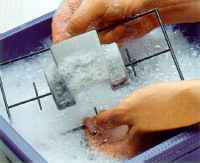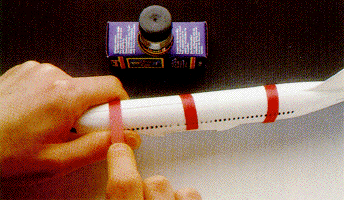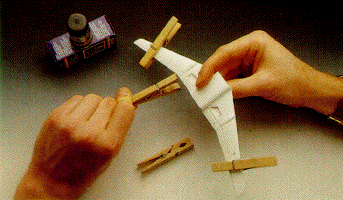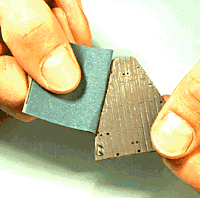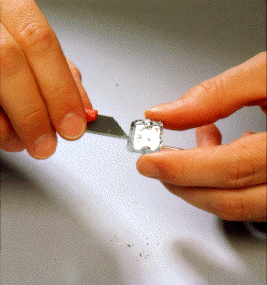Model paint comes in small glass bottles. The bottles are practically unbreakable, but
don’t test them by smashing them on the ground! Be careful when handling and storing
your paints, and they will last a long time. Always keep the jars in a box, such as an
empty show box or hobby center, and you won’t have to worry about paint from a broken
jar smearing the carpet. Most model paint is permanent. Once it is dry, it cannot be
easily removed from most model surfaces without special solvents. Open the bottle with
your fingers or a jar cap opener. Once the bottle is open, set it in the shoe box, hobby
center, or other container. Use a round toothpick to stir the paint gently. Make sure the
toothpick goes all the way to the bottom of the bottle while you stir.
Why is stirring necessary? Over time, even the finest model paints separate, and
stirring helps mix the ingredients again. Without stirring, the heavier part of the
paint--the pigment (or color)--will be at the bottom, and the paint at the top will be
runny and thin.
Stir for about a minute and remove the toothpick. Scrape the toothpick against the
inside rim of the jar to remove the excess paint. Use a new toothpick for each color.
The following describes some potential paint problems and always to avoid them:
Thickened Paint.
The most common cause of thickened bottled paint is evaporation of the enamel solvents
or water. The evaporation of the liquid is usually due to painting directly from the
bottle and while the paint is in storage. When brush painting an extended time, pour out
into a separate container the amount of paint required. Wipe away excess paint from around
the bottle rim prior to cap placement. Invert bottle during storage. These two suggestions
will reduce the evaporation process, increasing the paint's longevity. Paint will also
thicken or gel when the wrong thinner is used. A word of caution: not all thinners are
created equal. Use the recommended thinner for the product for the best results.
Although manufacturers recommend thinning ratios between paint and thinner, the
recommendations are starting points. Depending on the airbrush unit, power source and
environmental conditions, the ratios may vary. Recommendations, for example, for the
Pactra RC Racing Paints is 9 parts paint to 1 part RC thinner.
Thin Paint.
When experiencing watery, thin, low coverage bottled paint, the most common factor
associated with this is the insufficient mixing of the pigment and liquid. Merely shaking
the bottles will not provide the right viscosity of the paint to achieve coverage. A stick
or brush handle should be inserted into the paint and stirred until the pigment is not
longer settled on the bottom or sides of the bottle. This procedure should also be
followed when mixing paints before pouring into a cup and thinned for airbrushing. When
low coverage is experienced using aerosol paints, the two most common causes are that the
substrate needs to be color neutralized or a transparent color is being used. All Testor
Candy colors are transparent paints. If experiencing low coverage when airbrushing,
usually too much thinner has been added.
Orange Peel.
Orange peel is easy to spot. The finish resembles of the peel of an orange. It is
caused by the rapid evaporation of the solvents either while the paint is drying, or when
the paint is being applied. It becomes more pronounced at higher temperatures and/or when
lower humidity conditions exist. Orange peel can also happen if the aerosol paint can or
airbrush is held too far away from the object being painted under conditions, when using
too much thinner in an airbrush or allowing the model to dry in a spray booth with the
exhaust fan on. It is usually only visible on gloss finishes. Once orange peel develops,
it is necessary to remove the film and start over. Orange peel can be experienced when
applying enamels, polyurethane's, and vinyl acrylic lacquers.
Self-Lifting/Wrinkling.
"Self-lifting" is a common occurrence associated with gloss finishes. The
finish will resemble a spider web or cracked mirror appearance. Self-lifting occurs when
an application of paint is applied between 3 and 48 hours after the last application. To
eliminate this problem, only apply subsequent coats of enamel before three hours or after
48 of the last application. Self lifting can occur when applying enamel and polyurethanes.
Fish Eye.
"Fish Eye" is the formation of depressions or craters on the film with a
black dot in the middle of the bubble. This reaction occurs when there is contamination of
the product, equipment or environment. This can be extremely difficult to isolate and
eliminate the cause. Fish eye can occur on flat and gloss finishes with any product
formulas.
Bubbling.
Bubbling is the formation of many small bubbles in dried enamel film This can cause a
gloss finish to have a dull, rough appearance. This reaction is not uncommon when applying
gloss enamel solvent-based spray paints when humidity is excessively high. To reduce the
chance of bubbling, spray only when relative humidity conditions are 60% or lower.
Hazing/Blushing.
Hazing, associated with lacquers, appears as a cloudiness in the dried clear or
pigmented film. This reaction is commonly found with lacquers when relative humidity
conditions are high, trapping moisture in the dried film.
If hazing is experienced with Aero Gloss, once the humidity level has decreased, a
compatible lacquer thinner should be applied in a fine mist to the dried film. The thinner
dissolves the top layer of the lacquer film and allows the moisture to evaporate. This
will eliminate the hazy appearance. The application of too much thinner will result in
ruining the finish.
When hazing is experienced with Glosscote lacquer, apply mist applications of the
Glosscote when the humidity level decreases. The lacquer will dissolve the initial layer
of lacquer and allow the moisture to escape.
Runs, Sags, Drips.
Runs, sags, and drips are usually caused by the application of too much paint or
improper mixture of the paint. To avoid this, apply several light applications to build up
coverage, making sure that the bottled paint has been stirred or aerosol has been shaken.
Also, when applying a transparent paint, use gold, silver or copper primer as an under
coat. When a primer is not applied first, usually too much paint is applied in an attempt
to achieve opaque coverage ultimately causing runs, sags and drips.
Film Drying.
When paint is not drying on the surface, the most common cause is use of the wrong
paint. When painting flexible vinyl or rubber, Testors solvent based enamel will not dry.
A water based acrylic paint should be used. Dry time on Model Master acrylics, Pactra
acrylic and enamels is between 30 minutes to 1 hour. Lacquers dry even faster. However,
the environment and thickness of coats will have an impact on the amount of time it takes
for the films to thoroughly dry.
Diminished Adhesion.
It is important to wash your model with mild dishwashing detergent to remove model
release residue from the model. If any oily substance is on the model, the finish may
appear blotchy and have diminished adhesion. Adhesion will also be compromised if acrylics
are over thinned.
